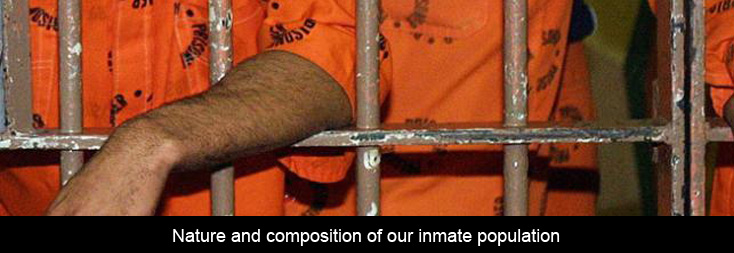Inmates will soon be utilized more to build and furnish schools in South Africa
Offender labour will soon be utilized more to build and furnish schools in South Africa.
This was announced today (19 November) by Correctional Services Minister Sibusiso Ndebele at a two-day national colloquium (19 and 20 November), hosted by the Department of Correctional Services in Johannesburg, to discuss overcrowding in correctional centres.
More than 170 representatives, from various organisations including government and civil society, are attending the colloquium to discuss overcrowding, alternative sentencing as well as remand detention management as part of solutions to South Africa’s high rate of incarceration and breaking the cycle of crime.
Delivering the opening address, Minister Ndebele said: “The Freedom Charter states that imprisonment shall be only for serious crimes against the people, and shall aim at re-education, not vengeance. It is accepted world-wide that 95% of all inmates, who are our brothers and sisters, our sons and daughters, will ultimately return to their communities at some point. Therefore, conviction and sentencing can no longer be meted in isolation from eventual reintegration.
“We must ensure that rehabilitation programmes impact the hearts, heads and hands of offenders. We are currently in discussions with the Department of Basic Education to utilize offender labour to build, maintain and manufacture furniture for schools. This is in addition to what is already being produced in correctional centres.
“Key to rehabilitation is empowering offenders with skills to function effectively in society upon their release but, equally important, is to ensure that offenders are actively involved in productive activity while they serve their sentences. Therefore, the establishment of a trading entity is being prioritised which will impact positively on utilisation of offender labour. Through this trading entity, we can offer our customer base consisting of government, NGO’s and the private sector a wide variety of products and services, ranging from furniture, clothing, steel works, food products, agriculture and many others. In addition, we will continue to donate these products to disadvantaged communities from time to time to help alleviate poverty.
“Overcrowding is, perhaps, the single most pressing concern facing correctional services around the world. The World Prison Brief currently places South Africa in the top ten in terms of our inmate population. South Africa has 51,8-million citizens, and our rate of imprisonment is the highest in Africa. Nigeria, the continent’s most densely populated country with 166,3-million people, has 51,560 inmates with 31 inmates for every 100,000 of its people. The national populations of the top six countries on the list range from 78-million in Iran to 1,3-billion people in China – with a combined total of more than 3-billion people. South Africa sits at number nine worldwide with 310 inmates for every 100,000 of its people. Of this, approximately 70% are sentenced offenders and approximately 30% are remand detainees. The population of offenders serving longer than 15 years (including life sentences) increased by 492% over the past two decades, from 4,995 during 1994/95 to 29,575 during 2010/11.
“In 1984, the driver of overcrowding in our country, (according to the Judicial Inquiry into the structure and functioning of the courts), was the incarceration of prisoners as a result of influx control measures. In 1985, the key driver was the mass detention of political prisoners as a result of the State of Emergency. From 1995 to 2004, the prison population increased from an annual average of 111,090 to an annual average of 186,467 in 2004. In the same period, the bed space gradually increased from 95,002 to 114,097 which translate to occupancy of 163.43% in 2004. On 31 October 2012, the total inmate population was 149,959 and the approved bed space was 118,968 which translates to occupancy of 126,05%.
“Overcrowding can, therefore, be the consequence of lack of adequate correctional facilities’ infrastructure, or a result of over use of imprisonment in the penal system. Over use of imprisonment includes indiscriminate, and even uncalculated, use of pre-trial detention. In other words, in order to determine the causes we need to analyze those offenders coming into our correctional facilities, and the reasons therefore, as well how long they stay and barriers to release.
“I am convinced that the deliberations today and tomorrow will bear fruit for future action and improvements in our correctional system. Let’s continue this dialogue towards finding solutions to South Africa’s high rate of incarceration and breaking the cycle of crime. Working together, we can do more,” the Minister said.
On 2 November 2012, the Mangaung Correctional Centre (MCC), situated just outside Bloemfontein, donated 32 refurbished desks to Gonyane Primary School. To date, MCC has revamped 1,528 school desks for primary schools in the greater Motheo district. The inmates of MCC, who received training in various skills, sanded down school desktops and gave it a fresh coat of paint. Those tops that could not be repaired were replaced with new tops. The frames were then spray-painted and the tops fitted. Old Mutual joined G4S Care and Justice Services in this outreach programme and donated funds for the purchasing of the material for the refurbishment process.
On 18 July 2012, Minister Ndebele, together with offenders, gave the underprivileged 46-year -old Tsakane Primary School in Tsakane Township near Brakpan in Gauteng a makeover. Offenders from the Boksburg Correctional Centre repaired desks, installed library shelves and burglar bars, cleaned the school yard, fixed broken classroom windows, repaired the fence, painted the school and developed a vegetable garden in order to alleviate severe infrastructural challenges at the school.
On 16 July 2012, Minister Ndebele was in Mpumalanga Province where the Ezakheni Combined School received a donation of 2,178 kilograms of five types of fresh vegetables, planted and cultivated by offenders from Piet Retief Correctional Centre, 900 grey trousers manufactured by offenders from Witbank Correctional Centre, 900 white shirts made by offenders from Mogwase Correctional Centre, several pairs of school shoes, and 834 dozen of eggs from Losperfontein Correctional Centre.





